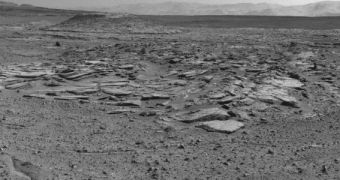Mission controllers at the NASA Jet Propulsion Laboratory (JPL) in Pasadena, California, announce that the Mars Science Laboratory (MSL) rover Curiosity has reached its intended science destination – a geologically complex site called Kimberly – on Wednesday, April 2. Scientists first planned to have the explorations robot investigate this site in early 2013, but the road there took longer than anticipated.
Two days ago, Curiosity was able to drive the final 30 meters (98 feet) separating it from Kimberly, a complex and intriguing area where four different types of rocks meet at a single location. The robot is scheduled to spend a few weeks here, conducting studies with multiple scientific instruments, including its mast-mounted laser and internal ovens.
JPL scientists say that Kimberly is one of the most promising areas when it comes to the possibility of detecting clues hinting at ancient Martian habitats that may have supported basic life. Curiosity is largely a geology mission, so it will investigate as many rocks at this location as possible, in hopes of finding ancient signs of organic molecules.
With the completion of Wednesday's drive, the rover's odometer now stands at 6.1 kilometers (3.8 miles). This is the distance it drove since its Sky Crane reentry and landing system deposited it on the floor of Gale Crater, on August 6, 2012. Its primary science target remains Mount Sharp, a 5-kilometer (3-mile) ejecta cone produced by the asteroid that created the 154-kilometer (96-mile) crater.
“This is the spot on the map we've been headed for, on a little rise that gives us a great view for context imaging of the outcrops at the Kimberley,” explains California Institute of Technology (Caltech) expert Mellisa Rice, who is the lead planner for Curiosity's investigations campaign at this site. The work will include sample-drilling, photo observations, and onboard sample analysis.
These studies will be the most complex that the rover has performed since spending nearly 6 months in early 2013 at a location called Yellowknife Bay. Curiosity spent such a long time at that location because its sensitive instruments were able to discover an ancient lakebed, which probably created an environment suitable for the development of basic life several billion years ago.
After it finishes studying the complex geology at Kimberly, Curiosity will continue onwards towards the slopes of Mount Sharp. JPL scientists do not currently know when this target will be reached, but they need to manage the 1-ton rover carefully. Already, the sharp Martian rocks have taken their toll on its wheels, causing dents and tears that might endanger the mission.
The MSL mission was launched into space as Launch Complex-41 (LC41) at the Cape Canaveral Air Force Station (CCAFS), in Florida, aboard an Atlas V heavy-lift delivery system flying in the 541 configuration, on November 26, 2011.

 14 DAY TRIAL //
14 DAY TRIAL //